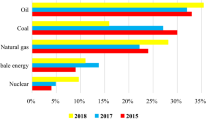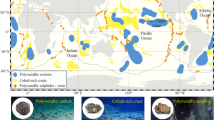Abstract
The continuous growth of the world population increases the demand and competition for energy, requiring an immense effort for nonrenewable energy sources availability. Application of marine currents for electricity generation could offer a distinct advantage over other renewable energy sources due to the regular and predictable nature of the resource. Therefore, in addition to promoting the development of new technologies, global policies for the generation of renewable and clean energy are being strengthened. Several methods of energy conversion have been developed over the years, especially the turbine-based current energy converter, which demonstrated high energy generation capacity and that have already been in operation. The tridimensional model TELEMAC3D was used to investigate the hydrodynamic processes. This model was coupled with the energy conversion module in order to prospect the best energy spots for marine current energy in the Southern Brazilian Shelf. The study area has shown two viable regions with high potential for exploitation of energy from marine currents, however, the more viable region for the installation of current converters is the northern region, bounded between the Conceição Lighthouse and the Solidao Lighthouse, reaching an average power around 10 kW/Day and integrated values of 3.5 MW/Year. The highest levels of power generation were found at intervals of 16 days, showing high correlation with events associated with the passage of meteorological fronts along the study region. This paper details the design of a turbines farm containing ten helicoidal turbines. With three grids a study computing one year of simulation with the TELEMAC-3D model coupled with the energy conversion module was carried out. It was possible to indicate an interest area for trial tests of modelling a turbine farm. The northern region site, on the structural scenario, stands out keeping high conversion rates during events of great potential energy. This improvement happens due to the intensification effects of the current field associated with the presence of the physical structure which enhances the efficiency of the site. No significant differences on the temporal variability pattern between the simulations studied were estimated, showing that the presence of the structures does not impact on changes in the energy conversion temporal pattern on the temporal scales studies in this work. The configuration settled for this study predicted an annual power output of 144,54 GWh which is equivalent to 0,53% of the whole energetic consumption of the Rio Grande do Sul State in 2010.
Similar content being viewed by others
References
Braga, M. F. and Krusche, N. (2000) - “Padrão de ventos em Rio Grande, RS, no periodo de 1992 a 1995”. Atlantica, 22:27–40.
Capeletto, G. J. and De Moura, G. H. Z. (2010) - “Balanço Energético do Rio Grande do Sul 2010: ano base 2009”.
Cornett, A. (2006) - “Inventory of Canada’s marine renewable energy resources”. Technical report, Canadian Hydraulics Center. CHC-TR-041.
Cruz, J. M. B. P. and Sarmento, A. J. N. A. (2007) - “Sea State Characterization of the Test Site of an Offshore Wave Energy Plant”. Ocean Engineering, (24):763–775.
Defne, Z. (2010) - “Multi-Criteria assessment of wave and tidal power along the Atlantic coast of the southeastern USA”. PhD thesis, Georgia Institute of Technology.
Douglas, C. A., Harrison, G. P., and Chick, J. P. (2008) -“Life cycle assessment of the Seagen marine current turbine”. In Proceedings of the Institution of Mechanical Engineers, Part M: Journal of Engineering for the Maritime Environment, page 1:12. v. 222.
EPRI (2006a) - “Maine Tidal InStream Energy Conversion (TISEC): Survey and Characterization of Potential Project Sites. EPRI-TP-003-ME.
EPRI (2006b) - “Massachusetts Tidal In-Stream Energy Conversion (TISEC): Survey and Characterization of Potential Project Sites. EPRI-TP-003-MA.
EPRI (2006c) - “New Brunswick Tidal In-Stream. Energy Conversion (TISEC): Survey and Characterization of Potential Project Sites. EPRI-TP-003-NB.
EPRI (2006d) - “Nova Scotia Tidal In-Stream Energy Conversion (TISEC): Survey and Characterization of Potential Project Sites. EPRI-TP-003-NS.
EPRI (2006e) - “Tidal InStream Energy Resource Assessment for Southeast Alaska. EPRI-TP-003-AK.
EPRI (2006f) - “Tidal power in North America Environmental and Permitting Issues. Technical report, Devine Tarbell & Associates Inc., Electric Power Research Institutes. EPRI-TP-007-NA.
Gordon, A. L. (1989) - “Brazil - Malvinas Confluence - 1984. Deep-Sea Research, 36:359–384.
Gorlov, B. A. (2010) - “Helical Turbine and Fish Safety, pages 1–14.
Hardisty, J, (2009) - “The Analysis of Tidal Stream Power”. The University of Hull, Kingston-upon-Hull, UK. John Wiley & Sons, Ltd. ISBN: 978-0-470-72451-4.321 p.
Hervouet, J. M. (2007) - “Free surface Flows: Modelling with the finite element methods”.
Hervouet, J. M. and Van Haren, L. (1996) - “Recent advances in numerical methods for fluid flows. In Anderson, M. G., Walling, D. E., and Bates, P. D., editors, Floodplain processes, pages 183–214. Wiley, Chichester.
Kalnay, E., Kanamitsu, M., Kistler, R., Collins, W., Deaven, D., Gandin, L., Iredell, M., Saha, S., White, G., Woollen, J., Zhu, Y., Chelliah, M., Ebisuzaki, W., Higgins, W., Janowiak, J., Mo, K. C., Ropelewski, C., Wang, J., Leetmaa, A., Reynolds, R., Jenne, R., and Joseph, D. (1996) - “The NCEP/NCAR 40-Year Reanalysis project. Technical report, Bulletin of the American Meteorological Society.
Khan, M. J., Bhuyan, G., Iqbal, M. T., and Quaicoe, J. E. (2009) - “Hydrokinetic energy conversion systems and assessment of horizontal and vertical axis turbines for river and tidal applications: A technology status review. Applied Energy, 86(10): 1823–1835.
Kirinus, E. P., Marques, W. C., and Stringari, C. E. (2012) - “Viabilidade de conversão da energia de correntes marinhas na Plataforma Continental Sul do Brasil”. Vetor, 22.
Kundu, P. K. and Cohen, I. M. (2002) - “Fluid Mechanics”. Second Edition. Academic Press. Orlando, USA. ISBN: 0-12-1782514. 766 p.
Marques, W. C. (2009) - “Estudo da dinâmica da pluma costeira da Lagoa dos Patos”. PhD thesis, Universidade Federal de Rio Grande.
Marques, W. C. (2012) - “The temporal variability of the freshwater discharge and water levels at the Patos Lagoon, Brazil”. International Journal of Geosciences.
Marques, W. C., Fernandes, E. H. L., and Moller, O. O. (2010b) - “Straining and advection contributions to the mixing process of the Patos Lagoon coastal plume, Brazil”. Journal of Geophysical Research, 115(C6).
Marques, W. C., Fernandes, E. H. L., Malcherek, A., and Rocha, L. A. O. (2012) - “Energy converting structures in the Southern Brazilian Shelf: Energy Conversion and its influence on the hydrodynamic and morphodynamic processes”. Journal of Geophysical Research.
Marques, W. C., Fernandes, E. H., Moller Jr, O. O., Moraes, B. C., and Malcherek, A. (2010a) - “Dynamics of the Patos Lagoon coastal plume and its contribution to the deposition pattern of the southern Brazilian inner shelf. Journal of Geophysical Research, 115.
Moller, O. O. J., Piola, A. R., Freitas, A. C., and Campos, E. J. D. (2008) - “The effects of river discharge and seasonal winds on the shelf off southeastern South America”. Continental Shelf Research.
Monteiro, I. O. (2006) - “Modelagem barotropica da pluma da Lagoa dos Patos”. PhD thesis, Universidade Federal de Rio Grande.
Myers, L. E. and Bahaj, A. S. (2012) - “An experimental investigation simulating flow effects in first generation marine current energy converter arrays,” Renewable Energy, vol. 37, 2012, pp. 28–36.
Piola, A. R. and Matano, R. P. (2001) - “Brazil and Falklands (Malvinas) currents”.
Piola, A. R., Matano, R. P., Palma, E. D., Moller, O. O., and Campos, E. J. (2005) - “The influence of the Plata River discharge on the western South Atlantic shelf. Geophysical Research Letters, 32:L01603.
Podestá, G. P. (1997) - “Utilizatión de datos satelitarios en investigaciones oceanográficas y pesqueras en el Océano Atlántico Sudoccidental”. In BOSCHI, E. E., editor, El mar argentino y sus recursos pesqueros., pages 195–222. Mar del Plata, Argentina.
Smagorinski, J. (1963) - “General circulation experiments with the primitive equation, I. The basic experiment”. Weather Review. 91, 99–164.
Torrence, C. and Compo, G. P. (1997) - “A practical guide to wavelet analysis”. Technical report, Bulletin of the American Meteorological Society.
Author information
Authors and Affiliations
Corresponding author
Rights and permissions
About this article
Cite this article
de Paula Kirinus, E., Marques, W.C. & Matzenauer, H.B. Insight into the usage of turbine current converters on the Southern Brazilian Shelf. Mar. Syst. Ocean Technol. 9, 113–124 (2014). https://doi.org/10.1007/BF03449292
Published:
Issue Date:
DOI: https://doi.org/10.1007/BF03449292




